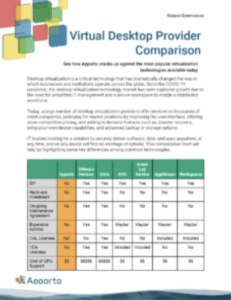Virtual Desktops and Flexible Learning Models in Higher Education
Modern higher education is undergoing a rapid transformation as institutions seek to adapt and innovate to meet the changing needs and expectations of students and faculty. One of the most exciting developments in this space is the emergence of virtual desktops, aka Cloud Desktops, and flexible learning models that enable greater access to education and support new approaches to teaching and learning. In this article, we explore the rise of virtual desktops in higher education and examine how they can be integrated into flexible learning models to create better educational experiences for all.
The Rise of Virtual Desktops in Higher Education
Virtual desktops are becoming increasingly popular in higher education due to their ability to provide access to powerful software and computing resources from any device, anywhere, at any time. Whether students are on campus or remote, virtual desktops can enable them to seamlessly access the resources they need to complete their coursework and assignments.
As technology continues to advance, virtual desktops have become a game changer for students and faculty alike. They offer a new level of convenience and flexibility that was previously unavailable, allowing for a more streamlined and efficient learning experience.
What are Virtual Desktops?
Virtual desktops are essentially virtual machines that run on a server and are accessed remotely via the internet. They provide users with a desktop interface that is identical to what they would experience if they were running the software locally on their own device. The main difference is that all of the processing and storage is happening on the server, rather than on the user’s device.
This means that students and faculty can access the same resources and software from any device, without having to worry about compatibility issues or software installation. It also means that institutions can more easily manage software and resources across multiple users and classes, without having to worry about hardware limitations or software conflicts.
Benefits of Virtual Desktops for Students and Faculty
One of the primary benefits of virtual desktops is the flexibility they offer. Students can access the resources they need from any device, without having to worry about compatibility issues or software installation. This can be especially helpful for students who may not have access to high-powered computers or who need to work while on the go.
Faculty also benefit from the use of virtual desktops, as they can more easily manage software and resources across multiple students and classes, without having to worry about hardware limitations or software conflicts. This can save time and resources while also reducing the risk of technical issues.
Another benefit of virtual desktops is the cost savings they can provide. By using virtual desktops, institutions can reduce the need for expensive hardware upgrades and maintenance, as well as the cost of software licenses and installations.
Implementing Virtual Desktops on Campus
Implementing virtual desktops on campus can be a complex process that requires careful planning and coordination. Some key considerations include selecting the appropriate software and hardware solutions, ensuring network compatibility and sufficient bandwidth, and developing policies and procedures for user access and support.
Despite these challenges, there are many resources and best practices available to help institutions successfully implement virtual desktops and maximize their benefits. For example, some institutions have established dedicated IT support teams or worked with vendors to provide managed virtual desktop services.
It’s also important to involve faculty and students in the planning and implementation process, as they will be the primary users of the virtual desktops. By soliciting feedback and input from these stakeholders, institutions can ensure that the virtual desktops meet their needs and are user-friendly.
Overall, virtual desktops are a powerful tool for higher education institutions looking to provide flexible and efficient access to software and computing resources. With careful planning and implementation, institutions can successfully harness the benefits of virtual desktops and improve the learning experience for students and faculty alike.
Flexible Learning Models: An Overview
Flexible learning models are another key trend in higher education that is changing the way students learn and interact with their instructors and peers. Flexible learning models prioritize student-centered approaches that adapt to individual needs and preferences, rather than traditional one-size-fits-all models.
Flexible learning models are becoming increasingly popular in higher education due to their ability to cater to different learning styles and preferences. These models are designed to be adaptable and customizable, allowing students to learn in a way that suits their needs and interests.
Traditional vs. Flexible Learning Models
Traditional learning models typically involve structured, classroom-based instruction that follows a set schedule and curriculum. While these models can be effective for some students, they can also be rigid and inflexible, leading to disengagement and frustration.
Flexible learning models, on the other hand, prioritize adaptability and customization, allowing students to learn at their own pace and in their own way. This can include online and hybrid courses, experiential learning opportunities, and competency-based learning models that focus on mastery of specific skills and knowledge.
Flexible learning models also prioritize collaboration and interaction between students and instructors. This can lead to a more engaging and dynamic learning experience, as students are able to share ideas and perspectives with their peers and receive personalized feedback from their instructors.
Types of Flexible Learning Models
There are many different types of flexible learning models, each with its own strengths and challenges. Some examples include:
- Online courses that provide students with the flexibility to complete coursework on their own schedule. Online courses can also be accessed from anywhere, making them ideal for students who need to balance their studies with work or family commitments.
- Hybrid courses that combine online and in-person instruction to provide a more balanced learning experience. Hybrid courses can be particularly effective for hands-on subjects that require both theoretical knowledge and practical skills.
- Project-based learning experiences that allow students to develop skills and knowledge through hands-on projects and real-world challenges. Project-based learning can be particularly effective for students who learn best through practical application.
- Credit-by-examination programs that enable students to demonstrate mastery of specific subject areas through standardized tests. These programs can be ideal for students who have prior knowledge or experience in a particular subject area and want to demonstrate their proficiency without taking a full course.
The Role of Technology in Flexible Learning
Technology plays a critical role in supporting flexible learning models, enabling students and faculty to communicate and collaborate more effectively, access resources from anywhere, and personalize their learning experiences. In addition to virtual desktops, some key technologies that support flexible learning include learning management systems, online collaboration tools, and mobile devices.
Technology also enables instructors to provide personalized feedback and support to students, regardless of their location or schedule. For example, instructors can use video conferencing tools to hold virtual office hours or provide one-on-one support to students who need extra help.
Overall, flexible learning models are a promising development in higher education, offering students a more personalized and engaging learning experience that can help them achieve their academic and career goals.
Integrating Virtual Desktops into Flexible Learning Models
Virtual desktops can be a powerful tool for supporting flexible learning models, enhancing accessibility and inclusivity, supporting collaborative learning, and facilitating personalized learning experiences.
Flexible learning models have become increasingly popular in recent years, as they allow for a more personalized and adaptable approach to education. Virtual desktops can play a key role in supporting these models, by providing students with access to a wide range of resources and tools, regardless of their location or device.
Enhancing Accessibility and Inclusivity
Virtual desktops can help to remove barriers to education for students with disabilities or who may not have access to specialized software or hardware. By providing a standardized platform that can be accessed from any device, virtual desktops can ensure that all students have access to the same resources and tools.
For example, students with visual impairments may require specialized software or hardware to access certain types of content. Virtual desktops can provide this functionality, without the need for students to purchase expensive equipment or software.
Similarly, students with mobility impairments may require specialized input devices or software to interact with their computer. Virtual desktops can provide these tools, without the need for students to physically manipulate their devices.
Supporting Collaborative Learning
One of the key benefits of flexible learning models is the opportunity for students to collaborate and learn from each other. Virtual desktops can enhance this experience by enabling students to share screens, work on shared documents in real-time, and communicate more effectively through video conferencing and chat tools.
For example, students working on a group project can use virtual desktops to collaborate in real-time, regardless of their physical location. They can share their screens, work on the same document simultaneously, and communicate through video conferencing or chat tools.
Virtual desktops can also support more traditional forms of collaboration, such as peer review and feedback. Students can share their work with their peers, who can then provide feedback and suggestions for improvement.
Facilitating Personalized Learning Experiences
Virtual desktops can also enable personalized learning experiences, allowing students to choose the software and resources that best suit their individual needs and preferences. This can include access to specialized software for certain disciplines, or the ability to customize the look and feel of their virtual desktop interface.
For example, a student studying graphic design may require access to specialized software such as Adobe Photoshop or Illustrator. Virtual desktops can provide this software, without the need for the student to purchase it themselves.
Similarly, students may have different preferences for the look and feel of their virtual desktop interface. Virtual desktops can provide customization options, allowing students to tailor their experience to their personal preferences.
Overall, virtual desktops can be a valuable tool for supporting flexible learning models, enhancing accessibility and inclusivity, supporting collaborative learning, and facilitating personalized learning experiences. As education continues to evolve, virtual desktops will likely become an increasingly important part of the learning experience.
Conclusion
Virtual desktops and flexible learning models are transforming higher education by enabling greater access, flexibility, and customization. While implementing these solutions can be challenging, the benefits for students and faculty are clear. By integrating virtual desktops into flexible learning models, institutions can create more inclusive, collaborative, and personalized educational experiences that prepare students for success in the 21st century.



